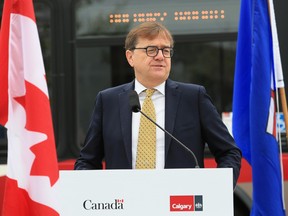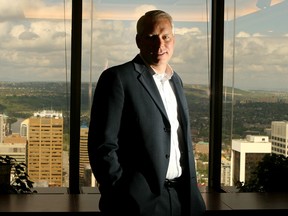The oilpatch emissions cap cometh, ushering in a Titanic struggle between the federal government, the province and the country’s oil and gas sector.
After two years of intense discussion, fierce debate and profound disagreement, the Trudeau government announced Thursday its new framework to cap and then cut greenhouse gas emissions from the country’s oil and gas industry. Ottawa billed it as the first such policy in the world from a major producing nation.
A long-simmering brawl over the cap, between the feds on one side and the Alberta government and industry on the other, is now fully underway.
Ottawa will adopt a cap-and-trade system through regulations under the Canadian Environmental Protection Act, aiming to wrestle down emissions in the sector by an expected 35 to 38 per cent by the end of the decade (from 2019 levels).
Industry leaders expressed frustration with the plan, while the Smith government vowed to construct a constitutional “shield” to stop it, which could involve using the province’s sovereignty act.
Federal Natural Resources Minister Jonathan Wilkinson said he expects production to rise as emissions fall under the plan, but Premier Danielle Smith insisted it’s a production cap that intentionally attacks the province’s economy and could lead to a national unity crisis if Ottawa proceeds with it.
“There’s no question that if they continue on this path, it will end up in court and I think we will win,” Smith told reporters Thursday from Dubai, where she’s attending the COP28 climate conference.
“We are facing a crisis of the federal government’s making, which is why they have to back down.”
First promised by the federal Liberals during the election campaign two years ago, the policy proposes to reduce industry emissions sharply through this decade as the country aims to reach net zero by 2050, a goal that has been adopted by Alberta and much of the industry.
A cap-and-trade system will set a limit on industry emissions by establishing a total quota of allowable emissions, which would decline over time, with the government distributing free allowances to regulated facilities.
Smith pointed out the province has the exclusive constitutional right to make laws on the development of its natural resources.
-
‘An intentional attack’: Alberta reacts to new federal oil and gas emissions cap
-
 Would Alberta win a court battle over the emissions cap? What is a cap-and-trade system? Here’s what you need to know
Would Alberta win a court battle over the emissions cap? What is a cap-and-trade system? Here’s what you need to know -
 Oil, gas emissions to be cut more than one-third by 2030, but offset credits allowed
Oil, gas emissions to be cut more than one-third by 2030, but offset credits allowed -
 Varcoe: ‘Nothing short of the NEP’ — Oilpatch girds for Ottawa’s new cap-and-trade emissions plan for sector
Varcoe: ‘Nothing short of the NEP’ — Oilpatch girds for Ottawa’s new cap-and-trade emissions plan for sector
The oil and gas sector was responsible for about 28 per cent of all emissions in Canada in 2021. With growing concerns about climate change, environmental groups largely applauded the move.
“This emissions cap will finally prompt oil and gas companies to divert record profits into major investments in decarbonization,” Janetta McKenzie of the Pembina Institute said in a statement.
“Existing policies are not enough.”
The sector is reducing emissions per barrel as global demand has reached record levels this year. The industry is a huge job creator — employing 412,000 Canadians directly and indirectly last year — while generating 30 per cent of Canada’s exports.
Ottawa estimates the cap will cover about 85 per cent of all emissions in the upstream oil and gas industry in 2021. The policy will apply to conventional oil and natural gas, offshore production and oilsands, as well as LNG facilities, but not to downstream refining and distribution.
The federal government pointed out the plan will include several flexibility measures, allowing companies to buy a limited number of carbon offset credits, or make contributions to a decarbonization fund if they exceed their allowances.
In an interview, Wilkinson said it’s not certain if the cap will apply to individual wells or small producers, noting this is a framework and draft regulations will be developed next year. Reporting and verification requirements for the cap would start as early as 2026.
The federal minister doesn’t think the policy will lead to investment dollars flowing south of the border, saying that risk is “very low.”
“We worked very hard to ensure that this is focused on emissions and not on production . . . It essentially will function as a backstop. You put your money where your mouth is, you do the things that you say you’re going to do — or there’s a requirement that you actually do them,” Wilkinson added.
“We’re quite confident in the federal government’s ability from a jurisdictional perspective to bring this into place.”

Industry reaction was swift.
Oilpatch veteran Hal Kvisle, the former CEO of TransCanada Corp. and Talisman Energy — and a director with several oil and gas producers — called the emissions cap an “ill-conceived move” by the federal government.
“None of our competitors in the United States are facing cap-and-trade restrictions,” said Kvisle.
“It is every bit as bad as the NEP.”
If the cap causes investment in the sector to shift to other jurisdictions, it will lead to fewer jobs and investment in Canada, warned Kevin Neveu, CEO of Precision Drilling Corp., the country’s largest driller.
While it won’t likely affect 2024 spending decisions, it will make it harder for companies to plan medium and long-term investments.
“This is a narrow policy and it’s prepared under the direction of an environmental activist. It’s solely focused on financially impairing the Canadian oil and gas producing industry,” said Neveu.
“This will result in investments being redirected and jobs being redirected away from Canada.”

There’s a lot on the line for all sides.
The Pathways Alliance, a group of major oilsands producers working to achieve net-zero emission by 2050, is developing a proposal to build a $16.5-billion carbon capture network connecting the oilsands to a storage hub near Cold Lake.
The alliance’s president said the group will analyze the federal framework, but Kendall Dilling believes the existing national carbon price and Alberta’s industrial emitters program “already provides appropriate regulation to drive emission reductions toward net zero by 2050.
“Imposing an emissions cap, with additional regulatory complexity, does nothing to advance the certainty necessary for the planned multibillion-dollar decarbonization projects to proceed,” he said in a statement.
Meanwhile, producers said the policy could lead to oil and gas output being shut in or future growth being stymied.
“We’re very disappointed,” said Tristan Goodman, president of the Explorers and Producers Association of Canada.
“It could have production implications. I think because of that, it’s likely unconstitutional, despite what the federal government is saying, and there’s going to be a lot of legal action associated with this.”
And a lot more fighting to come.
Chris Varcoe is a Calgary Herald columnist.
You can read more of the news on source



